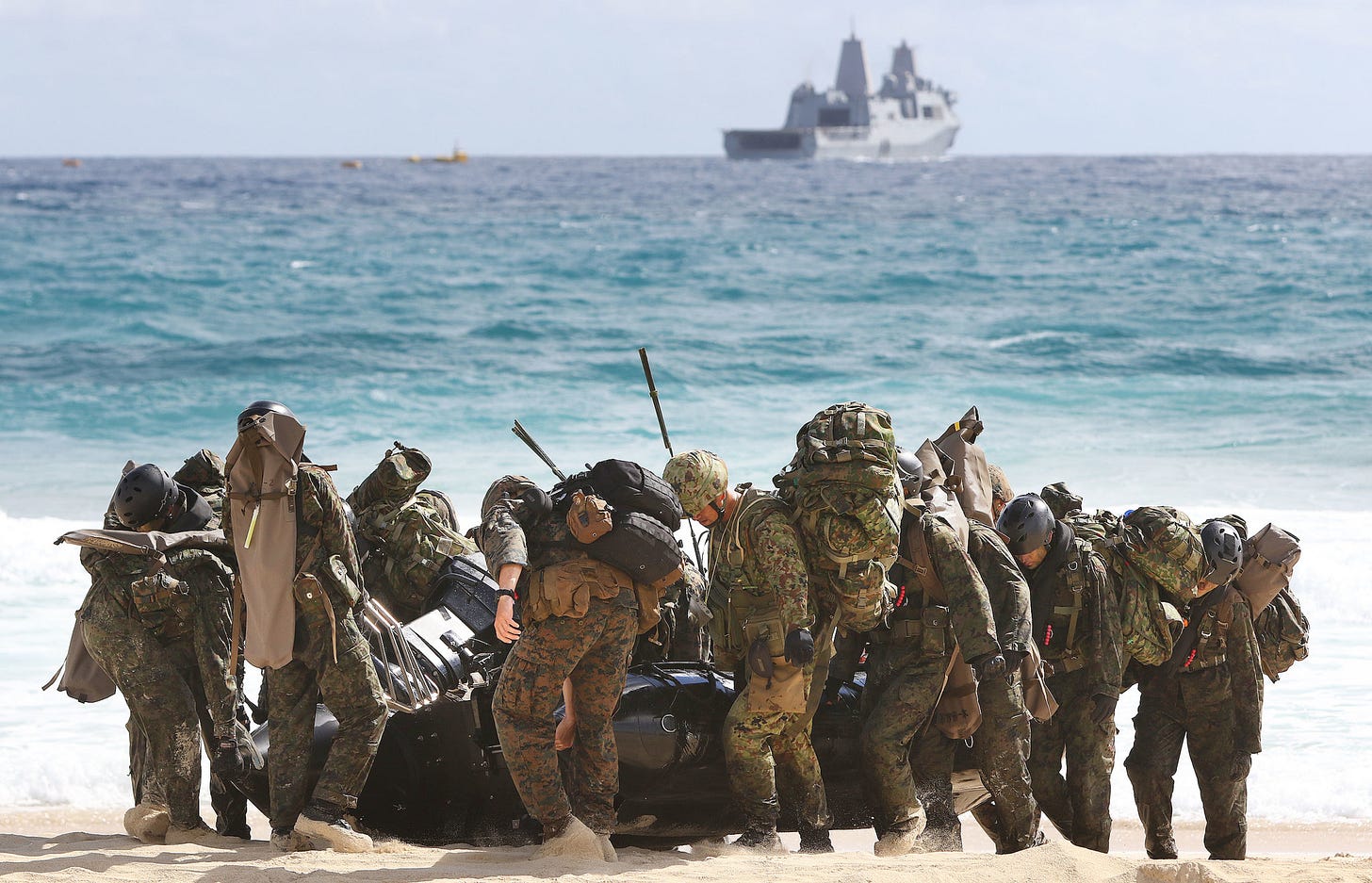GREY ZONE SITREP 03 FEB 22
In today's fast-paced world, it is more important than ever to stay informed about the latest developments in Grey Zone activity. Keep yourself in-the-know with the Grey Zone SITREP.
G’day team,
Welcome to this week's edition of the Grey Zone SITREP, where we delve into the complex world of international relations and the shifting political landscape.
As the global power dynamics continue to evolve, it's essential to stay informed on the latest developments and the potential implications for countries and businesses alike.
This week, we'll take a closer look at the re-establishment of the US embassy in the Solomon Islands, Japan's concerns with China's military activities, and the critical moment for NATO and Japan in the Indo-Pacific region.
Stay tuned for a comprehensive analysis of the current state of play and what it means for the future.
Furthermore, we're excited to offer you exclusive access to our need-to-know intelligence telegram channel, where we'll be providing you with niche China and Russia OSINT. This channel is for those who want to stay ahead of the curve on the current geopolitical landscape and have a deeper understanding of the actions and intentions of two of the world's most powerful nations.
Our team of experts are constantly monitoring the situation, gathering and analyzing information from credible sources to bring you the most accurate and interesting information. Stay informed and stay ahead of the game by joining our intelligence telegram channel today! All joining instructions will be sent to those who subscribe.
Enjoy!
POLITICAL
The United States Secretary of State, Antony Blinken, has announced the re-establishment of the US embassy in the Solomon Islands after a 30-year absence. The embassy, located in the capital city of Honiara, was officially established on January 27, 2021, and marks the US's effort to strengthen diplomatic relations in the Pacific region and counter the increasing influence of China.
The Indo-Pacific region, including the Pacific Islands, is poised to play a crucial role in shaping the world's trajectory in the 21st century, and the US's re-establishment of its embassy in the Solomon Islands is a significant step towards ensuring a US presence in the region. The move also comes amid warnings of the risk of conflict in the Indo-Pacific region, and Australia's Foreign Minister Penny Wong has stated that any conflict in the Indo-Pacific would be catastrophic for its people and prosperity.
The US's effort to broaden engagement and deepen international cooperation in the Pacific region also comes as Australia, the UK, and the US are expected to announce the design for Australia's new fleet of nuclear submarines, aimed at countering China's growing military power. NATO Secretary-General Jens Stoltenberg has also criticized China's actions towards its neighbors and Taiwan, and has emphasized the need for Japan and other democracies to work together with NATO to defend the international order.
In addition to the US's move, Japan's Foreign Minister Hayashi Yoshimasa has also expressed serious concerns to China's Foreign Minister Qin Gang about Beijing's military activities near Japan and its coordination with Russia. Hayashi has conveyed serious concerns over human rights issues in Hong Kong and the Xinjiang Uygur Autonomous Region, as well as the situations in the East China Sea, including the Senkaku Islands.
Analyst Comment. The re-establishment of the US embassy in the Solomon Islands and Japan's concerns towards China's military activities highlight the need for international cooperation to maintain the international rules-based order. Both the US and Japan are taking steps to ensure a presence in the Indo-Pacific region and to maintain peace and stability in the region. China is likely escalate their own grey zone activities in response.
MILITARY
The US and its allies are preparing for a potential conflict with China over Taiwan as the US Marine Corps units, designed for remote island fighting, will soon be positioned close to the island. The US Defense Secretary, Lloyd Austin III, recently announced that a Marine artillery regiment based in Okinawa, Japan, would be transformed into a Marine Littoral Regiment by 2025. This unit, known as the 12th Marine Littoral Regiment, will be equipped with advanced capabilities like anti-ship weaponry and improved intelligence, surveillance, and reconnaissance.
The 12th Marine Littoral Regiment is the second of three such regiments planned for the Indo-Pacific region, with the first activated in Hawaii in March 2022. The US and the Philippines also recently announced that US military forces would have access to four new bases in the Southeast Asian nation. This agreement is part of a larger US effort to expand its strategic presence in the Indo-Pacific to counter China’s threats.
During a recent visit to the Philippines, Defense Secretary Lloyd Austin and Philippine President Ferdinand Marcos Jr. discussed strengthening their relationship. President Marcos spoke about the complex situation in the Asia-Pacific region and the need for help from allies and partners, while Secretary Austin emphasized strengthening the relationship between the US and the Philippines.
As the visit progressed, Austin announced that the U.S. military will be granted access to four new bases in the Philippines, strengthening the United States' ongoing efforts to extend its strategic influence across the Indo-Pacific region as a countermeasure against potential threats from China. The new access agreement, which was finalized during Defense Secretary Lloyd Austin's visit, expands the five existing bases utilized for training, equipment pre-positioning, runway use, and other purposes under the 2014 defense cooperation agreement. Analyst Comment. Thursday’s announcement did not specify where the new bases would be.
However, despite the preparations, the US military may face challenges in the event of a conflict with China. The ongoing war in Ukraine has highlighted the difficulties with precision weapons, including their high cost, complex supply chains, and long production time. Despite calls for increased spending on long-range missiles, the limitations of the defense industry, including the shortage of rocket fuel, explosives, microelectronics, and skilled technicians, could slow down the production of key missiles.
Analyst Comment. While the US and its allies are making efforts to prepare for a potential conflict with China over Taiwan, they may face significant challenges in the absence of sufficient weapons stockpiles and the necessary infrastructure in the region. It remains to be seen how the situation will unfold, and what actions China's President Xi Jinping may take to achieve Indo-Pacific hegemony and a subjugated Taiwan.
ECONOMIC
The U.S. has achieved a significant victory by blocking China's access to critical chip technology, and in doing so, it has caused a rift between the Dutch government and the rest of Europe. The Netherlands recently agreed to restrict its sales of advanced microchip manufacturing equipment to China, with the U.S. government playing a key role in negotiating the deal. The country is home to ASML, a world-leading manufacturer of microchips printers, which makes the deal all the more significant.
This deal has put the Netherlands at the forefront of the tech war between the U.S. and China, and it has also left other European countries feeling powerless to intervene. The lack of an EU response has made the bloc vulnerable to retaliation from China, with critics arguing that this move has made the EU look weak in its relationship with the U.S.
On Monday, key European partners were left scrambling to respond to the news of the Dutch deal. The German government stated that it is "a matter of the Dutch," while the European Commission declined to comment on the reports about the deal. However, it did say that it remains in close contact with EU countries and allies on export controls.
The U.S. and India have also formally established a high-level initiative on defense and emerging technologies, known as the iCET. The initiative, which follows a commitment made by President Biden and Indian Prime Minister Narendra Modi last May, will promote joint production of defense equipment, including military jet engines, long-range artillery, and armored infantry vehicles. The national security advisor of the U.S., Jake Sullivan, called this "a strategic bet" on the relationship between the two democratic partners.
In other news, China's factory activity shrank more slowly in January than the previous month, due to the end of the country's zero-COVID policy. However, a private sector survey showed that infections among workers still hampered production. The data contrasted with a stronger-than-expected result from an official survey that showed manufacturing activity swinging back to growth. The official survey largely focuses on big and state-owned firms, while the Caixin survey centers on small firms and coastal regions, which includes many exporters. An economist at Capital Economics noted that the modest increase in the Caixin index suggests that smaller firms and exporters are facing the greatest headwinds amid weak foreign demand.
INFORMATION
China-based threat actors are continuing to target internet-facing devices and managed security services, with a new malware named "BOLDMOVE" being used to exploit a recent vulnerability in Fortinet's FortiOS SSL-VPN. The malware, which has both Windows and Linux variants, was discovered by Mandiant and is believed to be part of a larger cyber espionage operation by China. Internet-facing devices like firewalls, IPS/ID appliances are attractive targets as they can be exploited to gain access to a network without victim interaction and enable the attacker to control the timing and decrease the chance of detection.
Another threat, DragonSpark, is using the open-source remote administration tool SparkRAT to target East Asian organizations. SparkRAT is multi-platform and can run on Windows, Linux, and macOS systems. DragonSpark is seen as a Chinese-speaking adversary, either focused on espionage or cybercrime, and has been seen abusing the infrastructure of legitimate organizations in Taiwan, China, Hong Kong, and Singapore. DragonSpark uses China Chopper webshell to deploy malware, along with other tools developed by Chinese-speaking developers, and its C&C servers are located in Hong Kong and the US.
Analyst Comment. These threats highlight the importance of securing internet-facing devices, including managed security services, and regularly monitoring them for potential vulnerabilities or exploitation. It is also crucial to install additional security products, such as Endpoint Detection and Response, to better protect these devices from attack.
INFRASTRUCTURE
NSTR.
FROM THE OUTSTATIONS
HM Intelligence. Washington says Moscow is not complying with the pact as tensions soar over Russia's war in Ukraine. The treaty, which in its current state is due to continue until 2026, limits the two countries nuclear capabilities.
So What? Allegations of Russia's violation of the old START treaty were what led to its failure. However, it is unsurprising that Russia is unwilling to allow US inspectors to visit its sights due to the current situation in Ukraine. It is possible that the US is trying to use these inspections as a tactic to antagonise the Russian Government, yet it is also possible they are routine in nature and Russia's actions could lead to further tensions.
Expeditionary Intelligence. Last night, it was reported by eyewitnesses that several municipalities within Guanajuato, Mexico are suffering from elevated cartel violence. According to local media cartel members have been burning vehicles, and businesses as well as initiating firefights with security forces following the alleged capture of Cartel Santa Rosa de Lima (CSRL) leader “El Muneco.” The incidents began to occur around 22:30 local time when armed cartel members engaged with security forces in the Juventino Rosas, Celaya, and Villagran municipalities. By midnight videos began to circulate on social media of burning vehicles being used as roadblocks, and several convenience stores succumbing to arsonists. Police have confirmed that approximately 5 armed individuals were arrested, however, police have not yet confirmed the arrest of the high-profile individual.
Ever since Ovidio Guzman’s first arrest in 2019 and the events that transpired in what has been labeled as “Culiacanzo,” cartels have begun adopting this strategy to pressure the national government into surrendering high-profile individuals they arrested. Similar to “Culiacanzo” cartels have begun utilizing burning vehicles to set up roadblocks, informal checkpoints, destruction of property, and ambushes on security personnel to overextend local security forces, slow government movement, and cause terror in hopes of pushing the government into submission.
The CSRL emerged from the “post-fragmentation period” when many of the larger organizations began to decentralize breaking up into smaller cells and factions. The organization is mostly based in Guanajuato and has been found in some neighboring states, however, they have not made a permanent hold there yet. CSRL has proven itself to be extremely resilient as its been able to sustain itself in its constant fight with the much larger organization CJNG. Due to its geographic location, the group’s main activity is oil theft, but it has expanded into drug trafficking and extortion rackets that they are still trying to solidify. Despite this, the group has made it known that they aspire to become a multi-state organization rivaling some of the largest in the country.
THE COMPARTMENT
Analysis: Who would India side with in a war between the US and China or Russia?
Leaked Chinese J8 Doctrine
Leaked Chinese Type99A Armour Piercing Round data
All Chinese Incursions into Taiwan ADIZ - Jan 2023
Possible Chinese 6th Gen Fighter Concept Leak
Get access and read below!
Keep reading with a 7-day free trial
Subscribe to The Grey Zone to keep reading this post and get 7 days of free access to the full post archives.








